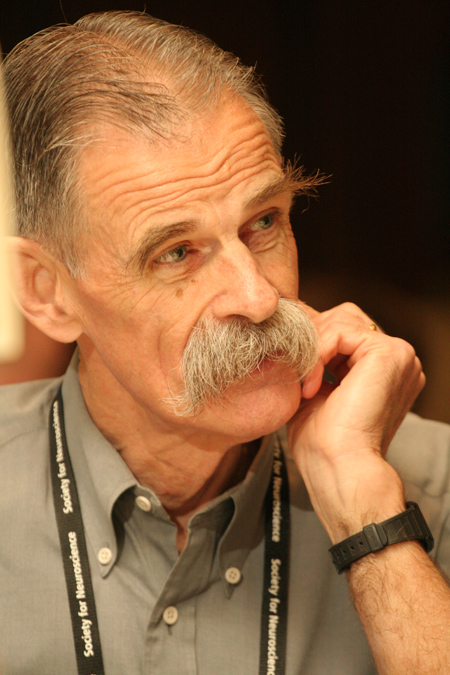By:
- Kim McDonald
Published Date
By:
- Kim McDonald
Share This:
New Website to Open World of Neurosciences to Public
Co-director of UC San Diego’s Kavli Institute for Brain and Mind to Serve as editor in chief

Nick Spitzer
Which of the following statements are true? We only use 10 percent of our brain. Listening to classical music can make us smarter. Brain damage is permanent. Alcohol kills brain cells. If you’ve said none of the above, congratulations. If you said one or more, read on. These statements are among the many “neuromyths” that UC San Diego neurobiology professor Nick Spitzer hopes to dispel through a new resource for the public called Brain Facts.Org, which will be available online in May. Spitzer, who is also co-director of the university’s Kavli Institute for Brain and Mind, has just been named the editor in chief of the online resource, which will be supported with $1.53-million over the next six years by the Kavli Foundation, the Society for Neuroscience and The Gatsby Charitable Foundation. Given that March 12 to 16 is Brain Awareness Week, we posed some questions to the new editor about the brain and his new online project.
Q: What is Brain Awareness Week and what should the public be aware about the brain and mind that we don't already know about?
Brain Awareness Week is an initiative of the Dana Foundation and the Society for Neuroscience that aims to make the public more aware of the discoveries of brain research and the societal benefits that accrue from these research findings. Neuroscience is one of the most dynamic fields in the life and health sciences today. New knowledge is being generated at a prodigious rate. This knowledge helps to satisfy our insatiable curiosity about who we are and how we behave as we do. It has permeated society and led to the generation of new fields of inquiry in neuroeconomics, neuroethics and neurolaw. It is leading to the development of new therapies for neurological and psychiatric disorders.
Q: The Society for Neuroscience has a primer for the public called Brain Facts. What is BrainFacts.Org, how does it differ from this primer and why is it being created?
BrainFacts.book has been a mainstay of the outreach and education efforts of the Society for Neuroscience for many years. It has been available to anyone wanting to learn the basics about the brain and has been a guide to students studying for Brain Bee competitions. It is revised and updated periodically and the good news is that a new edition will be appearing soon. However, the world is turning increasingly from print to digital media, and the global reach of the Internet makes it a great medium for education. BrainFacts.org will be a unique public nonprofit website providing authoritative information about the brain to the curious public, K-12 students, patients and patient advocates, and policy makers and the press.
Q: What are some of the exciting features of the new website and how the public and educators will be able to interact with and use it?
The new website will launch in early May, thanks to the generous support of our founding content partners, the Gatsby and Kavli Foundations. It's organized with pull-down menus for different topics: introductory articles will lead with a click to those with more details, and one will be able to "drill down" to find the level of information that one desires. "Meet the Researcher" will acquaint viewers with the people advancing our knowledge. Social media (Facebook, Twitter, blogs) will engage viewers. "Ask an Expert" will provide opportunities to ask questions and get answers; polls will assess the depth of interest in different subjects that will then be presented on the site. We think that people will be able sense the thrill of scientific discovery as they expand their knowledge of brain and mind.
Q: What are some “neuromyths” that you hope BrainFacts.Org will dispel?
One prevalent neuromyth is that “we only use 10 percent of our brain.” Not true! We use all of our brain–although not all at the same time. One can easily appreciate this from the fact that a stroke impairs our performance no matter where in the brain it occurs. “Listening to classical music makes you smarter"”–often referred to as “the Mozart effect.” Unfortunately, repeated testing has not supported this charming idea. The idea that “brain damage is permanent” turns out to be incorrect. We've learned that remarkable levels of recovery can be achieved with therapy and training. Many believe that “drinking alcohol kills brain cells.” Of course drinking heavily and chronically will kill brain cells, but moderate levels (e.g. a glass of wine) do not and appear to be healthful.
Q: How will the Kavli Institute for Brain and Mind at UC San Diego be involved in this new venture?
The KIBM has the overarching goal of bringing together neuroscientists, psychologists, cognitive scientists, linguists, anthropologists and others to link our understanding of the mechanisms of the brain to the behavior of the mind. It nurtures research activity in the La Jolla community. New insights into the functions of adult neurogenesis and the process of infant language learning, by KIBM researchers, are just a few of the local discoveries that are likely to be part of BrainFacts.org. I, Terry Sejnowski [of UC San Diego and the Salk Institute] and others at the institute will be reviewing and editing material for the website. Fred Kavli and the Kavli Foundation are keenly interested both in fostering scientific discovery and in promoting public education. We are very fortunate to enjoy their support of both of these important objectives!
Share This:
You May Also Like
$10 Million Grant from Price Philanthropies Launches Behavioral Health Hub at UC San Diego Health
Health & BehaviorStay in the Know
Keep up with all the latest from UC San Diego. Subscribe to the newsletter today.



